
At the end of 2024, Paul-Tech installed three real-time soil stations beneath the UK’s most legendary tree – the Major Oak in Sherwood Forest. These stations are now delivering their first insights on soil moisture, nutrient levels, and temperature at depths of 30 and 70 cm. By analysing two layers, the system reveals how conditions vary within the soil profile.
The stations were placed in three different zones: one in undisturbed soil beneath the Major Oak’s canopy, another in soil that had been treated through aeration and organic matter addition, and a third under a nearby control tree. The monitoring began on 27 November 2024, and the data now covers the winter period up to 21 March 2025.
Sherwood’s Iconic Oak
The Major Oak – one of Britain’s largest and oldest oaks – is said to have been the hiding place of Robin Hood and his band of outlaws in Medieval times. Today, it draws around 350,000 visitors a year to Sherwood Forest, each hoping to see the 1,200-year-old native English oak (Quercus robur).
Over the years, various protective measures have been introduced to preserve the tree, including support structures and fencing to safeguard its roots. Soil quality was previously checked periodically. Now, with Paul-Tech’s real-time monitoring, conservationists can continuously track the tree’s growing environment and respond more precisely to its evolving needs.
Soil Moisture and Nutrients
The treated soil clearly retained more moisture, thanks to improved water-holding capacity from loosening and organic enrichment. The control site recorded the lowest moisture levels, while the undisturbed soil variant placed in between.
Nutrient levels were significantly higher in the treated soil compared to the other variants. As soil temperatures began to rise in spring, nutrient levels in the treated soil also increased. The effects of the treatment extended as deep as 70 cm, where nutrient levels closely matched those in the upper layer. In both the untreated and control variants, nutrient levels remained stable throughout the winter. The control variant had the lowest levels overall, with fewer nutrients in the upper than the lower layer. The undisturbed variant performed slightly better, especially at 30 cm depth.
Soil Temperature
From December to mid-January, soil temperatures were relatively similar across all three locations. After that, the control tree’s soil began to show slightly cooler temperatures compared to both Major Oak sites, which remained closely aligned. The coldest average daily minimum at 70 cm was recorded on 13 January in the undisturbed (compacted) soil – 3.3°C – indicating greater thermal conductivity in dense soil. The average soil temperature over the observation period was 6.3°C in both the treated and untreated soils beneath the Major Oak, while the control area was 0.4°C cooler.
Conclusion
Based on data from the real-time soil stations, it can be concluded that aerating the soil and adding humus-rich organic matter had a clear positive impact on both moisture retention and nutrient availability — at both 30 and 70 cm depths. So far, monitoring has only covered the winter season, but measurements will continue into the summer. Ideally, long-term monitoring over several years would provide even deeper insights into the lasting benefits of soil treatment.
We hope that by improving its living conditions, this ancient oak will gain renewed vitality – and perhaps add a few more centuries to its remarkable life story.